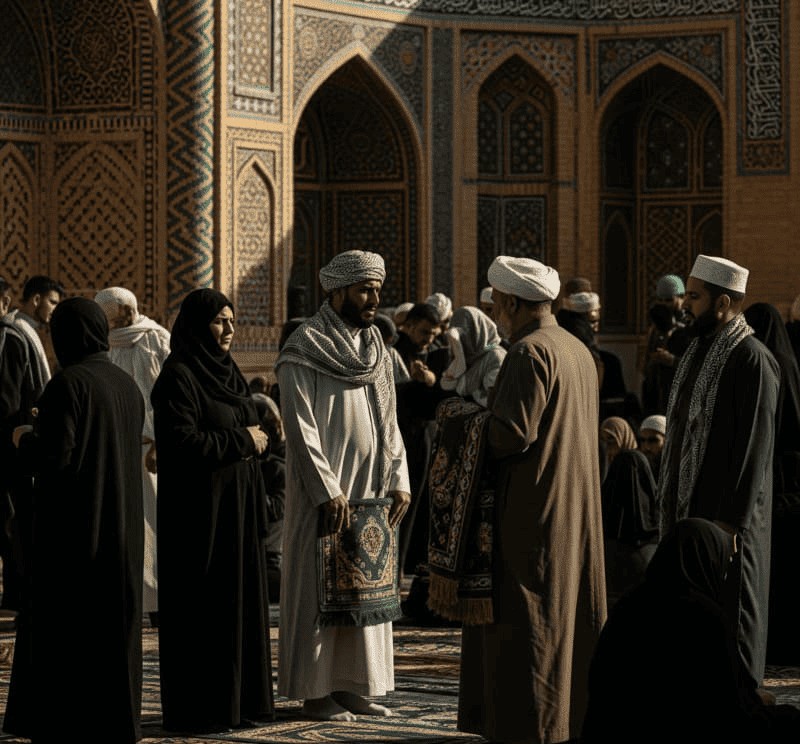Introduction
Iraq is considered the cradle of many Sufi orders that have enriched the spiritual and cultural life of the Islamic community over the centuries. Among these orders, the Kasanazaniyya Order stands out as one of the most prominent Sufi schools that originated and developed in Iraqi lands. Tracing the roots and origins of this order opens a window into a long history of spiritual education, Sufi practice, and deep connection to Islamic doctrine through its esoteric and mystical dimensions.
Historical Roots of Sufism in Iraq
Iraq is one of the most important historical centers where Islamic Sufism originated and developed since the early centuries of the Hijra. Thanks to its geographic location between the East and West of the Islamic world, and its hosting of prominent scholars, jurists, and Quranic commentators, Iraq naturally became a nurturing ground for the emergence and spread of Sufi orders. Cities like Baghdad, Mosul, Kirkuk, and Sulaymaniyah witnessed widespread spiritual movements since the 3rd century Hijri, where zawiyas (Sufi lodges) were integral parts of the social and religious fabric.
The school of Junayd of Baghdad played a fundamental role in establishing the scientific and behavioral foundations of Sunni Sufism. This school influenced subsequent generations of Sufis both inside and outside Iraq. Later, in the 6th century Hijri, Imam Sheikh Abdul Qadir al-Jilani appeared as one of the greatest figures in Sunni Sufism, founding the Qadiriyya Order in Baghdad, which spread throughout the Islamic world.
This rich background provided the foundation for new branches of Sufi orders, including the Kasanazaniyya Order, which is considered a spiritual extension of the Qadiriyya but distinguished by its practical and spiritual characteristics developed over time in the Iraqi environment, particularly in the Kurdish areas of northern Iraq.
The Origin of the Kasanazaniyya Order
The Kasanazaniyya Order traces its origin to Sheikh Abdul Karim Shah al-Kasanzan, who lived in the 20th century and is considered the actual founder of this Sufi order, which emerged from the region of Kasanzan near the city of Kirkuk in northern Iraq. The order’s name is derived from this area, becoming known as the “Kasanazaniyya Order,” referring to the founder’s homeland and shrine.
Sheikh Abdul Karim al-Kasanzan was a true man of the path, raised upon the foundations of Qadiri Sufism, as his spiritual lineage traces back to Sheikh Abdul Qadir al-Jilani. Thus, the Kasanazaniyya Order is essentially an extension of the Qadiri chain but took its own unique path in terms of naming, organizational function, and social expansion.
What distinguishes the founding of the Kasanazaniyya Order is that it was not merely a nominal branch of the Qadiriyya but the result of a long spiritual journey and practical Sufi education. Sheikh Abdul Karim was known for his miracles, spiritual struggles, and karamat (spiritual gifts) that attracted disciples from various regions.
Over time, the order became more institutionalized, leadership of the order passed down from father to son . Sheikh Muhammad Abdul Karim al-Kasanzan succeeded his father, playing a significant role in expanding the order’s scope, consolidating its foundations, teachings, and organization both inside Iraq and abroad.
Thus, the Kasanazaniyya Order emerged within an authentic Iraqi Sufi context but presented itself with a new approach combining tradition and spiritual uniqueness.
The Spiritual Lineage and Relations of the Kasanazaniyya Order
The Kasanazaniyya Order is neither an innovated nor disconnected order from the origins of Islamic Sufism. It is connected to a noble spiritual chain tracing back to Sheikh Abdul Qadir al-Jilani, one of the greatest symbols of Sufism in Islamic history. Like traditional Sufi orders, the Kasanazaniyya relies on a chain of masters known as the “Golden Chain,” linking the current sheikh to the Prophet Muhammad ﷺ through an uninterrupted series of saints and mystics.
This chain, called the “Silsila al-Izin” (Chain of Authorization) or the spiritual chain, grants the disciple legitimacy of reception and affiliation. In the Kasanazaniyya Order, this chain is an essential part of the spiritual identity, recited in some gatherings and preserved by the sheikhs and disciples.
A distinguishing feature of this chain in the Kasanazaniyya is its affirmation as a living, unbroken chain, including prominent masters of the Qadiriyya until it reaches Sheikh Abdul Karim al-Kasanzan, then Sheikh Muhammad, then Sheikh Nahro—may God sanctify their secrets.
The close relationship between the Kasanazaniyya and the Qadiriyya Orders is clear: the former is a spiritual and organizational extension of the latter but has developed independent practical features, such as the method of dhikr (remembrance), spiritual training, distribution of deputies, and expansion of concepts of karamat and miracles, giving it a distinctive character among the many Qadiri branches.
The Transformation from the Qadiriyya Order to the Kasanazaniyya Order
As mentioned earlier, the Kasanazaniyya Order belongs to Qadiri roots in terms of spiritual lineage and general methodology, but it underwent a gradual transformation that distinguished it in naming, practice, and organization. This transformation was not a split or departure from the Qadiri approach but a natural development arising from the founder’s personality, Sheikh Abdul Karim al-Kasanzan, and his unique spiritual experience.
The name “Kasanazaniyya” was derived from the Kasanzan region, where Sheikh Abdul Karim resided—located in Kirkuk province, northern Iraq. As the sheikh’s fame grew and his miracles became evident, disciples began referring to his path as the “Kasanazaniyya Order,” distinguishing it from other Qadiri branches spread throughout Iraq and the Islamic world.
Prominent features of this transformation included:
- Emphasis on collective, dynamic dhikr involving bodily movement with praise, which became a major attraction in the order’s gatherings.
- Expansion of concepts of karamat and miracles, including the manifestation of physical signs during dhikr (such as sword or needle piercing) as evidence of divine protection.
- Establishment of a disciplined administrative system with spiritual and field ranks such as khalifa (deputy), murshid (guide), wakil (agent), khadim (servant), and others.
- Opening the order to various sects and ethnicities, avoiding confinement to narrow ethnic or sectarian frameworks.
Thus, the Kasanazaniyya Order evolved from being a branch of the Qadiriyya to an independent order with millions of followers in Iraq and extensions in countries like Iran, Syria, Lebanon, Turkey, Pakistan, Europe, and America.
This transformation was the fruit of decades of spiritual education and social interaction, granting the order a prestigious position in the Iraqi spiritual landscape.
The Position of the Kasanazaniyya Order in Iraqi Society
The Kasanazaniyya Order enjoys a distinguished position in Iraq’s spiritual and social scene, transcending the traditional confines of zawiyas to become a widely spread social Sufi phenomenon with a clear influence among diverse Iraqi populations, especially in the north and central regions.
Geographic Spread
The order primarily spreads in:
- Kurdistan Region of Iraq: especially in the governorates of Kirkuk, Sulaymaniyah, and Erbil. The order originated in the Kasanzan area near Kirkuk city, which remains its spiritual center.
- Central and Southern Regions: followers and disciples are found in Baghdad, Diyala, Anbar, Babil, Wasit, and Dhi Qar.
- International Spread: the order expanded to neighboring countries such as Iran, Syria, and Turkey, then to Europe and America, with zawiyas and spiritual centers in London, Berlin, Michigan, and elsewhere.
Cross-Sectarian Popular Acceptance
One of the most remarkable features of the Kasanazaniyya Order is its ability to break sectarian and ethnic barriers, including:
- Arabs, Kurds, and Turkmen.
- Sunnis and Shi’as.
- New Muslims and some non-Muslims who embraced Islam through practices of dhikr and spirituality.
This openness made the order a bridge for spiritual and social communication among multiple segments of Iraqi society, in a country suffering from sectarian and political divisions.
Cultural and Social Influence
The order plays roles in:
- Promoting a culture of inner peace and tolerance.
- Organizing spiritual gatherings and religious celebrations attracting thousands of disciples.
- Supporting charitable works and serving the poor and needy.
- Preserving Sufi heritage through zawiyas, lessons, and regular sessions.
The order has proven its social presence even under the most difficult security and political conditions, serving as a symbol of spiritual steadfastness and national loyalty in the face of extremism and division.
Conclusion
The Kasanazaniyya Order represents a living example of the renewal of Islamic Sufism in the modern era, without losing its originality or deep spiritual roots. It derives its legitimacy from the blessed Qadiri chain but presents itself in a manner compatible with the changes of time and place, making it widely accepted by many people.
Through its broad geographic spread, openness to all ethnicities and sects, and renewal of methods of dhikr and spiritual education, the Kasanazaniyya Order has achieved a distinctive Sufi presence inside Iraq and abroad, offering a positive image of Sufism that is not closed upon itself but strives to reform the individual and society and promote human and spiritual values.
This expansion continues, especially with media and educational activities carried out by the order’s institutions, aimed at spreading the culture of dhikr, monotheism, and love, and presenting Sufism as a practical path for purifying
souls and building harmonious communities.

